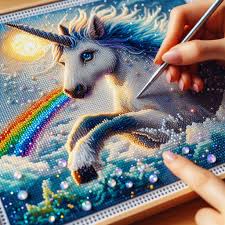The intricate process of creating a painting of a diamond involves several sophisticated techniques that highlight an artist's mastery over materials and understanding of optical properties. Each technique contributes to rendering the brilliant and complex nature of diamonds in art.
Layering and Glazing
One of the primary techniques used is layering and glazing. Artists often apply multiple thin layers of paint to achieve the diamond’s luminous and reflective qualities. This method allows for the creation of depth and brilliance, mimicking how light passes through and bounces off a real diamond. Typically, an artist might use anywhere from ten to twenty layers, gradually building up the light and color to reflect the stone's multi-faceted surface.
Precision Brushwork
Precision is key when painting the sharp, clean edges and the precise facets of a diamond. Artists utilize fine brushes, often with just a few bristles, to outline each facet accurately. This meticulous approach ensures that each geometric line is distinct and contributes to the overall perception of depth and form. This kind of brushwork demands not only a steady hand but also an eye for minute details, often requiring several hours of focused work per square inch of the painting.
Color Mixing
Diamonds capture and split light into a spectrum of colors, a phenomenon known as dispersion. Replicating this effect in paint requires sophisticated color mixing skills. Artists must understand the subtle balance of hues to portray the play of light within the diamond. This often involves creating custom color blends for each facet, depending on how it interacts with light. The ability to mix precise shades is crucial and can dramatically affect the realism of the diamond depicted.
Use of Mediums
To enhance the reflective qualities of a painted diamond, artists may incorporate various mediums into their paints. These mediums can increase the transparency or the glossiness of the paint, lending a gem-like quality to the artwork. For example, adding a medium that enhances the thickness and gloss can mimic the reflective index of a real diamond, making the painting shimmer and sparkle under light.
Understanding of Light Physics
A deep understanding of light physics is essential for effectively painting diamonds. Artists must know how light behaves when it strikes different surfaces, especially transparent and reflective ones like diamonds. This knowledge influences everything from color choice to brush direction and is critical in achieving the realistic sparkle and brilliance that diamonds are known for.
Crafting a Convincing Diamond Painting
Each technique used in a painting of a diamond serves to create a visual simulation that is both convincing and captivating. These methods are not just about technical execution but also about capturing the essence of what makes diamonds so visually appealing. For more insights into the artistic process and the techniques behind diamond paintings, visit Painting of a Diamond. These techniques not only showcase an artist’s technical skill but also their creative ability to translate complex visual experiences onto canvas.

